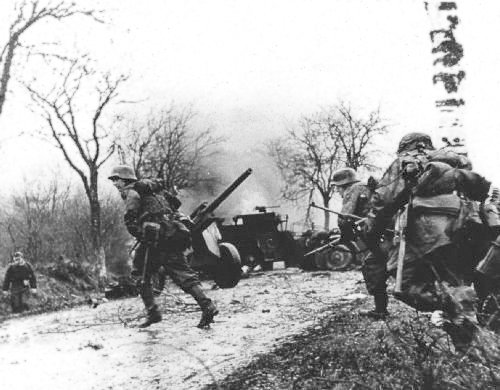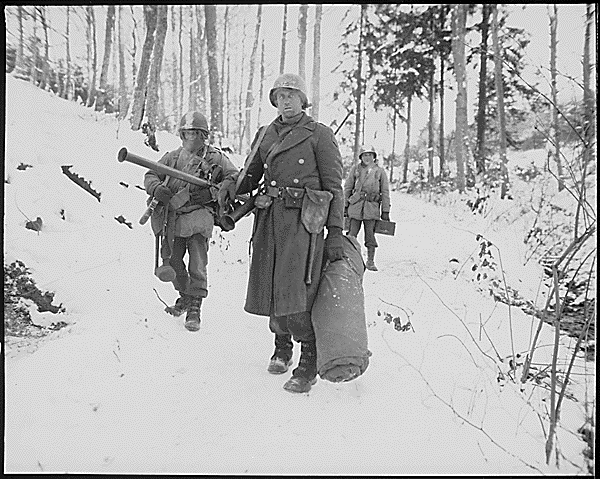On 16 December 1944 Hitler launched his final gamble on the Western Front; an assault on the Ardennes that he was convinced would change the course of the war. It would go on to be the largest and most costly battle fought by the US Army in World War II as they bore the brunt of the German offensive.
The extract below explores the origins of the German Plans. It is taken from Campaign 115: Battle of the Bulge 1944 (1) by Steven J. Zaloga.
The idea for the Ardennes offensive came to Hitler in mid- September 1944 during his recuperation from the 20 July 1944 bomb plot. Albert Jodl, the chief of the Wehrmacht operations staff, made a casual mention that the Ardennes was the most weakly held sector of the Allied front. Hitler immediately connected this remark with the bold Panzer drive across the Meuse in 1940 that had led to the stunning victory over France. Given Germany’s desperate circumstances Hitler convinced himself that a success in the west could change the course of the war. In his fevered mind, the alliance between Britain and the United States was fragile, and if their forces could be separated by an assault to the sea, the Allied front would collapse. Hitler dreamed that a third to a half of the Allied divisions on the western front could be destroyed. A similar offensive in other theaters held out no opportunity. Jodl was assigned the task of elaborating Hitler’s plans and he submitted the first draft on 11 October 1944.
German soldiers run past abandoned US equipment
Source: Wikipedia
The Ardennes offensive was shaped by earlier German counteroffensives. Two previous Panzer operations against the advancing US Army – near Mortain in early August and in Lorraine in September – had failed. Although the attacking German forces had modest numerical superiority in both battles, this was not enough when faced by American artillery and air power. Hitler concluded that the Ardennes operation would require substantial superiority in men and materiel. Since only four American divisions were holding the Ardennes, Hitler calculated that a total of about 30 German divisions would be needed. Given the weakened state of the Wehrmacht after the summer disasters, such a force could not be assembled until late November 1944, but the poor weather in the late autumn would hobble Allied air power. An essential element of the plan, first dubbed Wacht am Rhein (Watch on the Rhine), was total secrecy. Since the attempted military coup of July 1944, Hitler had a pathological distrust of the commanders of the regular army. Details of the plan were kept to an absolute minimum of planners, and the movement of troops and materiel to the German frontier in the late autumn was explained as an effort to prepare for Allied offensives over the Rhine that were expected in the New Year.
The offensive was aimed at the Ardennes sector most weakly held by the US Army from Monschau in the north to Echternach in the south, a distance of about 60km. The neighboring German sector in the Eifel was heavily wooded, shielding fresh German units from aerial observation. The offensive would be conducted by three armies: two Panzer armies in the north and center and a relatively weak infantry army on the southern flank to block counterattacks against this shoulder. Hitler would have preferred to use only his trusted Waffen-SS Panzer divisions, but there were not enough. So he settled on an attack by the 6th (SS) Panzer Army in the vital northern sector with a parallel assault by the 5th Panzer Army in the center. The 6th Panzer Army sector from Monschau to St Vith was the most important, since success here would secure the shortest route over the Meuse through Liège to Antwerp. German planners believed that the main logistics network for the First US Army was in this area and its capture would assist the German attack by providing supplies as well as weakening the American response. The weakest of the attacking German armies, the 7th Army, would strike towards Bastogne. Unlike the two Panzer forces to the north, the 7th Army had virtually no armored support. Bastogne had little role in the original Ardennes plan since it was quite distant from any strategic objectives. The Waffen-SS Panzer commanders were fairly confident they could reach the Meuse river in a day or two, and the plan considered that it might be possible to reach Antwerp by the seventh day of the offensive.
US Engineers near Wiltz, Luxembourg
Source: Wikipedia
[…]
Wacht am Rhein was foolhardy with few realistic chances for success. The quality of German forces in the late autumn of 1944 had plummeted drastically since the summer, due to the catastrophic losses in France and eastern Europe. The plan could only succeed if the initial American defenses could be rapidly breached and if the US Army dawdled as the Panzers raced for the Meuse. This was pinned on Hitler’s exaggerated estimation of German combat power and a dismissive underestimation of American battlefield prowess. Any delays in reaching key objectives would doom the plan, since many key routes through the wooded hill country of the Ardennes could be blocked by relatively small forces at choke points and key river crossings. Delays of only a few days would be fatal since the Americans could use their better mobility to reinforce the Ardennes. The plan’s logistical underpinning was suspect. Fuel and ammunition were in short supply and once the offensive began, the rail lines running into the Eifel would be relentlessly bombed regardless of weather, preventing re-supply.
Interested in reading more? Campaign 115: Battle of the Bulge 1944 (1) and Campaign 145: Battle of the Bulge 1944 (2) are both available at a 20% discount if you use the voucher code BOTB. This voucher covers both print and digital versions of the book.
Please note that the print versions for both books are Print-on-Demand. These will be shipped separately to other books you order and may take 2 weeks longer to be dispatched.




Comments
You must be logged in to comment on this post. Click here to log in.
Submit your comment